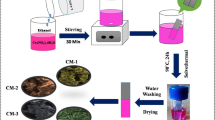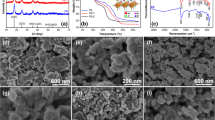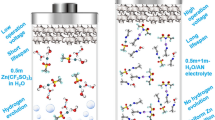Abstract
Manganese tetravalent oxide (MnO2), a superstar Faradic electrode material, has been investigated extensively for capacitive desalination, enabling higher salt adsorption capacity compared to the great majority of carbonous electrodes. However, few works paid attention on the relationship between the valences of manganese oxide and their desalination performance. For the first time, we prepared the spindle-like manganese oxides/carbon composites with divalent (MnO@C), trivalent (Mn2O3@C) and divalent/trivalent (Mn3O4@C) manganese by pyrolysis of manganese carbonate precursor under different condition, respectively. The electrochemical behavior in three-electrode system and electrosorption performance obtained in hybrid membrane capacitive deionization (HMCDI) cells assembled with capacitive carbon electrodes were systematically evaluated, respectively. High salt adsorption capacity (as large as 31.3, 22.2, and 18.9 mg·g−1) and corresponding average salt adsorption rates (0.83, 0.53, and 1.71 mg·g−1min−1) were achieved in 500 mg·L−1 NaCl solution for MnO@C, Mn2O3@C, and Mn3O4@C, respectively. During fifteen electrosorption-desorption cycles, ex-situ water contact angle and morphology comparison analysis demonstrated the superior cycling durability of the manganese oxide electrodes and subtle difference between their surface redox. Furthermore, density functional theory (DFT) was also conducted to elaborate the disparity among the valence states of manganese (+2, +3 and +2/+3) for in-depth understanding. This work introduced manganese oxide with various valences to blaze new trails for developing novel Faradic electrode materials with high-efficiency desalination performance by valence engineering.

Similar content being viewed by others
References
Pekel, J. F.; Cottam, A.; Gorelick, N.; Belward, A. S. High-resolution mapping of global surface water and its long-term changes. Nature 2016, 540, 418–422.
Wang, Z. D.; Tian, S. H.; Niu, J. J.; Kong, W.; Lin, J. Y.; Hao, X. G.; Guan, G. Q. An electrochemically switched ion exchange process with self-electrical-energy recuperation for desalination. Sep. Purif. Technol. 2020, 239, 116521.
Al-Zoubi, H.; Al-Amri, F.; Khalifa, A. E.; Al-Zoubi, A.; Abid, M.; Younis, E.; Mallick, T. K. A comprehensive review of air gap membrane distillation process. Desalin. Water Treat. 2018, 110, 27–64.
Alkhudhiri, A.; Darwish, N.; Hilal, N. Membrane distillation: A comprehensive review. Desalination 2012, 287, 2–18.
Han, D.; He, W. F.; Yue, C.; Pu, W. H. Study on desalination of zero-emission system based on mechanical vapor compression. Appl. Energy 2017, 185, 1490–1496.
Elimelech, M.; Phillip, W. A. The future of seawater desalination: Energy, technology, and the environment. Science 2011, 333, 712–717.
Zhou, J.; Zhou, H. J.; Zhang, Y. Z.; Wu, J.; Zhang, H. M.; Wang, G. Z.; Li, J. X. Pseudocapacitive deionization of uranium(VI) with WO3/C electrode. Chem. Eng. J. 2020, 398, 125460.
Wang, G. Z.; Yan, T. T.; Zhang, J. P.; Shi, L. Y.; Zhang, D. S. Trace-Fe-enhanced capacitive deionization of saline water by boosting electron transfer of electro-adsorption sites. Environ. Sci. Technol. 2020, 54, 8411–8419.
Wu, T. T.; Wang, G.; Zhan, F.; Dong, Q.; Ren, Q. D.; Wang, J. R.; Qiu, J. S. Surface-treated carbon electrodes with modified potential of zero charge for capacitive deionization. Water Res. 2016, 93, 30–37.
Ding, M.; Fan, S.; Huang, S. Z.; Pam, M. E.; Guo, L.; Shi, Y. M.; Yang, H. Y. Tunable pseudocapacitive behavior in metal-organic framework-derived TiO2@porous carbon enabling high-performance membrane capacitive deionization. ACS Appl. Energy Mater. 2019, 2, 1812–1822.
Srimuk, P.; Lee, J.; Fleischmann, S.; Choudhury, S.; Jäckel, N.; Zeiger, M.; Kim, C.; Aslan, M.; Presser, V. Faradaic deionization of brackish and sea water via pseudocapacitive cation and anion intercalation into few-layered molybdenum disulfide. J. Mater. Chem. A 2017, 5, 15640–15649.
Lumley, M. A.; Nam, D. H.; Choi, K. S. Elucidating structure-composition-property relationships of Ni-based Prussian blue analogues for electrochemical seawater desalination. ACS Appl. Mater. Interfaces 2020, 12, 36014–36025.
Lee, J.; Kim, S.; Yoon, J. Rocking chair desalination battery based on Prussian blue electrodes. Acs Omega 2017, 2, 1653–1659.
Xu, Y. S.; Zhou, H. J.; Wang, G. Z.; Zhang, Y. X.; Zhang, H. M.; Zhao, H. J. Selective pseudocapacitive deionization of calcium ions in copper hexacyanoferrate. ACS Appl. Mater. Interfaces 2020, 12, 41437–41445.
Wu, T. T.; Wang, G.; Wang, S. Y.; Zhan, F.; Fu, Y.; Qiao, H. Y.; Qiu, J. S. Highly stable hybrid capacitive deionization with a MnO2 anode and a positively charged cathode. Environ. Sci. Technol. Lett. 2018, 5, 98–102.
Li, M.; Park, H. G. Pseudocapacitive coating for effective capacitive deionization. ACS Appl. Mater. Interfaces 2018, 10, 2442–2450.
Leong, Z. Y.; Yang, H. Y. A study of MnO2 with different crystalline forms for pseudocapacitive desalination. ACS Appl. Mater. Interfaces 2019, 11, 13176–13184.
Kim, Y.; Ha, K. H.; Oh, S. M.; Lee, K. T. High-capacity anode materials for sodium-ion batteries. Chem.-Eur. J. 2014, 20, 11980–11992.
Kang, H. Y.; Liu, Y. C.; Cao, K. Z.; Zhao, Y.; Jiao, L. F.; Wang, Y. J.; Yuan, H. T. Update on anode materials for Na-ion batteries. J. Mater. Chem. A 2015, 3, 17899–17913.
Yusoff, N. F. M.; Idris, N. H.; Din, M. F. M.; Majid, S. R.; Harun, N. A.; Rahman, M. M. Investigation on the electrochemical performances of Mn2O3 as a potential anode for Na-ion batteries. Sci. Rep. 2020, 10, 9207.
He, Y. Z.; Xu, P.; Zhang, B.; Du, Y. C.; Song, B.; Han, X. J.; Peng, H. S. Ultrasmall MnO nanoparticles supported on nitrogen-doped carbon nanotubes as efficient anode materials for sodium ion batteries. ACS Appl. Mater. Interfaces 2017, 9, 38401–38408.
Qin, Y. M.; Jiang, Z. Q.; Guo, L. P.; Huang, J. L.; Jiang, Z. J. Controlled thermal oxidation derived Mn3O4 encapsulated in nitrogen doped carbon as an anode for lithium/sodium ion batteries with enhanced performance. Chem. Eng. J. 2021, 406, 126894.
Wang, L. Z.; Tang, F. Q.; Ozawa, K.; Chen, Z. G.; Mukherj, A.; Zhu, Y. C.; Zou, J.; Cheng, H. M.; Lu, G. Q. A general single-source route for the preparation of hollow nanoporous metal oxide structures. Angew. Chem., Int. Ed. 2009, 48, 7048–7051.
Thommes, M.; Kaneko, K.; Neimark, A. V.; Olivier, J. P.; Rodriguez-Reinoso, F.; Rouquerol, J.; Sing, K. S. W. Physisorption of gases, with special reference to the evaluation of surface area and pore size distribution (IUPAC Technical Report). Pure Appl. Chem. 2015, 87, 1051–1069.
Zhang, J.; Lin, J.; Zeng, Y. B.; Zhang, Y.; Guo, H. Morphological and structural evolution of MnO@C anode and its application in lithium-ion capacitors. ACS Appl. Energy Mater. 2019, 2, 8345–8358.
Tan, Q. Y.; Li, X. T.; Zhang, B.; Chen, X.; Tian, Y. W.; Wan, H. Z.; Zhang, L. S.; Miao, L.; Wang, C.; Gan, Y. et al. Valence engineering via in situ carbon reduction on octahedron sites Mn3O4 for ultra-long cycle life aqueous Zn-ion battery. Adv. Energy Mater. 2020, 10, 2001050.
Wang, R. F.; Ma, Y. Y.; Wang, H.; Key, J.; Brett, D.; Ji, S.; Yin, S. B.; Shen, P. K. A cost effective, highly porous, manganese oxide/carbon supercapacitor material with high rate capability. J. Mater. Chem. A 2016, 4, 5390–5394.
Jiang, M.; Abushrenta, N.; Wu, X. C.; Li, Y. P.; Sun, X. M. Investigation for the synthesis of hierarchical Co3O4@MnO2 nanoarrays materials and their application for supercapacitor. J. Mater. Sci. Mater. Electron. 2017, 28, 1281–1287.
Sawangphruk, M.; Srimuk, P.; Chiochan, P.; Krittayavathananon, A.; Luanwuthi, S.; Limtrakul, J. High-performance supercapacitor of manganese oxide/reduced graphene oxide nanocomposite coated on flexible carbon fiber paper. Carbon 2013, 60, 109–116.
Ma, Y.; Ma, Y. J.; Kim, G. T.; Diemant, T.; Behm, R. J.; Geiger, D.; Kaiser, U.; Varzi, A.; Passerini, S. Superior lithium storage capacity of α-MnS nanoparticles embedded in S-doped carbonaceous mesoporous frameworks. Adv. Energy Mater. 2019, 9, 1902077.
Ma, J.; Xiong, Y. C.; Dai, X. H.; Yu, F. Zinc spinel ferrite nano-particles as a pseudocapacitive electrode with ultrahigh desalination capacity and long-term stability. Environ. Sci. Technol. Lett. 2020, 7, 118–125.
Tian, Z. N.; Tong, X. L.; Sheng, G.; Shao, Y. L.; Yu, L. H.; Tung, V.; Sun, J. Y.; Kaner, R. B.; Liu, Z. F. Printable magnesium ion quasi-solid-state asymmetric supercapacitors for flexible solar-charging integrated units. Nat. Commun. 2019, 10, 4913.
El-Deen, A. G.; Barakat, N. A. M.; Kim, H. Y. Graphene wrapped MnO2-nanostructures as effective and stable electrode materials for capacitive deionization desalination technology. Desalination 2014, 344, 289–298.
Quan, X. P.; Fu, Z. B.,; Yuan, L.; Zhong, M. L.; Mi, R.; Yang, X.; Yi, Y.; Wang, C. Y. Capacitive deionization of NaCl solutions with ambient pressure dried carbon aerogel microsphere electrodes. RSC Adv. 2017, 7, 35875–35882.
Khan, Z. U.; Yan, T. T.; Shi, L. Y.; Zhang, D. S. Improved capacitive deionization by using 3D intercalated graphene sheet-sphere nanocomposite architectures. Environ. Sci. Nano 2018, 5, 980–991.
Liu, Y.; Xu, X. T.; Wang, M.; Lu, T.; Sun, Z.; Pan, L. K. Metal-organic framework-derived porous carbon polyhedra for highly efficient capacitive deionization. Chem. Commun. 2015, 51, 12020–12023.
Xu, X. T.; Pan, L. K.; Liu, Y.; Lu, T.; Sun, Z.; Chua, D. H. C. Facile synthesis of novel graphene sponge for high performance capacitive deionization. Sci. Rep. 2015, 5, 8458.
Chen, B. W.; Wang, Y. F.; Chang, Z.; Wang, X. W.; Li, M. X.; Liu, X.; Zhang, L. X.; Wu, Y. P. Enhanced capacitive desalination of MnO2 by forming composite with multi-walled carbon nanotubes. RSC Adv. 2016, 6, 6730–6736.
Acknowledgements
This work was financially supported by the National Key R&D Program of China (No. 2017YFA0207202) and the National Natural Science Foundation of China (Nos. 51872291 and 51872292).
Author information
Authors and Affiliations
Corresponding authors
Electronic supplementary material
Rights and permissions
About this article
Cite this article
Xu, Y., Xiang, S., Mao, H. et al. Pseudocapacitive desalination via valence engineering with spindle-like manganese oxide/carbon composites. Nano Res. 14, 4878–4884 (2021). https://doi.org/10.1007/s12274-021-3467-z
Received:
Revised:
Accepted:
Published:
Issue Date:
DOI: https://doi.org/10.1007/s12274-021-3467-z




